I have had 50% success rate for over-wintering my bees. I like to take a glass-half-full perspective with this. It could be a lot worse for sure. The 50% that do not make it, I try to look at as a learning experience. I try my best to figure out what went wrong.
Let’s back up to a couple of months ago…
The weather finally broke and another long and cold and snow-filled winter. We had a nice-ish day. So, I made my way back to my little apiary to try to determine if I had any losses.
I started the winter with two colonies. I knew from watching the bees on their cleansing flight that I had at least one survival (Yay – celebration time!). I was unsure about the second colony, though I felt a foreboding at the lack of buzzing from inside and the lack of bee excrement on the outside.
I carefully opened the top cover.
I then made my way through the strong propolis seal they had carefully constructed around everything within the hive. There they were. Thousands of bees, unmoving. Death had stopped them at the end of winter. Lifeless little bodies. Many looked as though they had only recently perished.
With a saddened heart, I scooped them out by the handful and looked them over to try to determine the “why” of it.
I did see moisture. My best guess is that I had not added enough space to the top to prevent moisture. The colony had been buried under a great deal of snow. I will consider my options and address this in the fall.
Fast forward back to today! Happiness is here in the form of honeybees. I have new packages and the beehives have been readied. It is installation day!
Here is what I did:
I brought out to the apiary a spray bottle of sugar water, my bee suit, my hive tool, my bee brush, and -of course- my bees.
I observed that the bees were tightly clustered around their queen. This is a great sign. It means they have accepted her pheromone scent and are attracted to her. (note, if they are in a hot area, they will uncluster as a way to keep cooler inside their shipping cage).
I misted them with my sugar water to give them something to do–not a lot, just enough to keep them busy and not drowning. Next, I thumped the cage on the ground to drop the bees to the bottom while I opened the cage. Yes, that’s right. I thumped them and knocked them down. They did not get upset at all – another good sign that all is well with these bees.
I carefully removed the canister of bee food (sugar water) from the top using my hive tool to open up the hole.
(Note: Photo below was posed and taken before thumping the bees to the bottom)
Then, I poured the bees into the hive between the two frames of already started beeswax from another colony that I was lucky to have.
I removed the small queen cage and removed the cork from the end.
I replaced the two missing frames ever so gently to not squish anyone and then sandwiched the queen cage in between so the queen could free herself from her little container.
I placed the cover on with the top entrance closed off. I put an entrance reducer on the bottom board with a very small opening in it to prevent any immediate departure of the entire colony and I set the cage in front of the entrance so that any lingering bees could find their way in.
And I watched as the lingering bees made their way out of the cage, found the scent of their queen and followed it into their new home.
I will go back in in three days to remove the queen cage and check on the well-being of the ladies. If all is well, I will provide a larger opening in the entrance reducer. Another check in a couple of weeks and I will hope to find signs of reproduction taking place.
This is the start of another opportunity to be a student in the lessons of the honeybees. I’m so glad it is here and cannot wait for them to teach me even more than they already have.
Note: My way of doing this is not necessarily the correct way. However, this is what I do and it has worked for me many, many times.
–Kelly Vander Kley

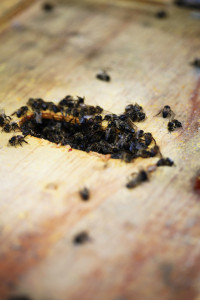
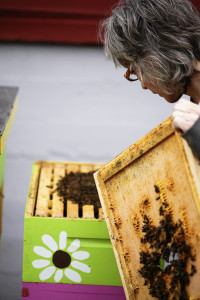
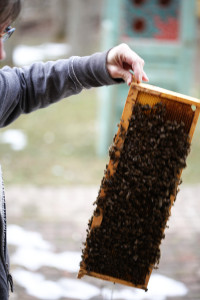

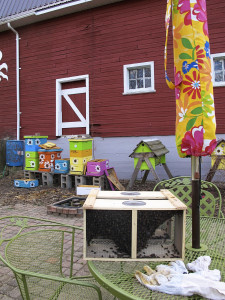

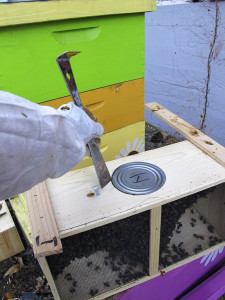
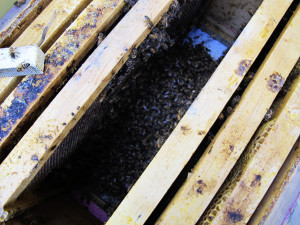

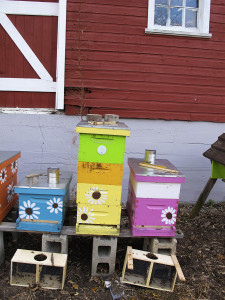


Thank you for taking the time to share this information! Did you put feed on them yet? Or will you?
Thanks so much from a second year beekeeper with one surviving hive and 3 packages coming soon.
Last year I presented a tried and true method to successfully overwinter your bees. All my 17 hives survived the winter. If the Kalamazoo Bee Club invites me back, I will present my proven methods again with a few more proven updates.
Nice article. Well written with nice photos.
Great contribution, Kelly! Thanks!